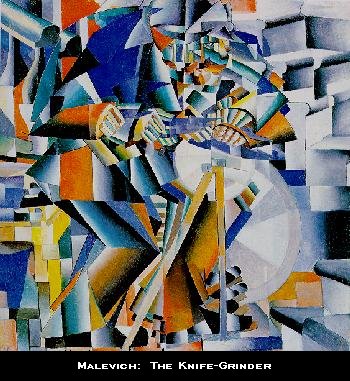

Cubo-futurism developed in Russia around 1910. It was essentially a synthetic style, a reinterpretation of the French Cubism (Picasso and Braque) and Italian Futurism (Marinetti, Boccioni) popular at that time in Europe, combined with a strong Neo-primitivist belief in the dynamic possibilities of color and line. The Cubo-futurist movement attracted such talented artists as Goncharova, Larionov, Popova, Malevich, Tatlin, and many others. In Russian interpretation, sometimes there is no significant difference between a Cubist and Cubo-futurist painting. Both feature bold colors, and the fragmentation of the objects on the canvas' surface. Perhaps Cubo-futurism places more emphasis on movement and action; it is also often characterized by the inclusion of various letters, even complete words, in the composition. Goncharova's The Cyclist (1912-13), Popova's Italian Still-Life (1914) and Seated Figure (ca. 1915), as well as Malevich's An Englishman in Moscow (1914) and The Knife Grinder (1912) are not only good examples of the painterly possibilities opened up by the Cubo-futurist style but also excellent illustrations of various artistic approaches to it. The Knife-Grinder shows some of Cubo-futurism's most characteristic features, including
the fragmentation of forms (derived from Cubism)
the focus on movement (from Futurism)
the bold colors and lines (from Neo-primitivism)
a general departure from objectivity.
The painting is composed to render a "dynamic rhythm" that gives it a peculiar kind of unity. Cubo-futurism was the last major art movement in Russia before the artists surrendered to non-objective art so forcefully introduced by Suprematism. [B.B. and C.B.]
